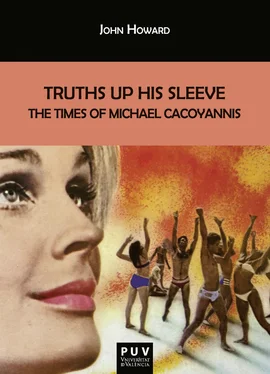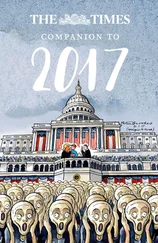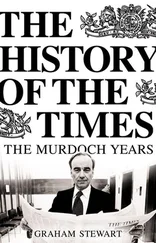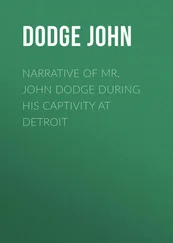This book explains why. Tracking the cosmopolitan Cacoyannis, it probes his life and times—interrogating, as he did, the twentieth century’s thorniest political, cultural, and ethical dilemmas. Praised as a brilliant modernist, classicist, feminist, and humanist, Cacoyannis suffered debilitating personal setbacks and—as a gay man—massive professional obstacles. Nonetheless he persisted. He relied on his keen intellect and boundless resourcefulness to write, direct, produce, and even costume some of the most enduring, alluring, and incisive motion pictures of all time. Battling his own demons, defying his nastiest critics, Michael did it all with a principled resoluteness, combined with the continuous help of a small circle of tried-and-true colleagues and friends—plus a few fellow travellers whose contributions only now can be revealed.
Published just after the 100 thanniversary of his birth, the 10 thanniversary of his death, this first critical biography of filmmaker and stage director Michael Cacoyannis (1921-2011) assesses his large body of work with reference to the sociopolitical context of his times. It explores his complex thematic concerns across multiple genres, which also included radio plays, short stories, translations, memoirs, manifestos, and still photography. The study reinterprets significant secondary literatures to argue that an accurately characterized woman-centered modernist oeuvre furthermore incorporated path-breaking queer critique, class analysis, and critical race insights. Historicized understandings of race as tied to place, the book claims, were informed by Cacoyannis’ reading and translation of ancient texts, as well as his own upbringing on the eastern Mediterranean island of Cyprus, at the crosscurrents of Africa, Asia, and Europe. Hailed as an astute classicist for his popular adaptations of Aristophanes, Sophocles and especially Euripides, Cacoyannis insisted on ancient Greek drama’s continuing relevance and contemporary application to anticolonial, antiwar, and antinuclear struggles. A secular humanist, he believed in a finite set of enduring truths, while helping to usher in the era of postmodern skepticism. A frugal cosmopolitan working across several continents and languages, he welcomed the progressive gains of globalization, this book demonstrates, even as he forcefully denounced its persistent inequities and injustices.
Organized into three parts of three to four chapters each, the book examines Michael Cacoyannis’ early years of schooling, training, and employment (1921-1953), his ascendance as both an auteur and popular filmmaker (1953-1967), followed by political exile and later life as a grand man of the stage (1967-2011), with considerable overlap across chapters. It argues that his life’s work — sixteen feature films, over thirty dramatic productions, seven opera presentations, and more—coheres around consistent themes, rich symbolism, provocative topics, and candid treatments, such that several movies and source texts were banned, censored, or attacked. As many of these already have sustained intense scholarly scrutiny, this book emphasizes undervalued works, overlooked innovations, and mistaken intentions.
In particular, Truths Up His Sleeve confronts and refutes scholar Vrasidas Karalis’ damning indictment from 2012. According to Karalis, Michael Cacoyannis’ “conservative politics and his hidden sexuality never allowed him to develop the full potential of the visual language that he constructed [with his first five films] in the 1950s.” Based on new evidence from previously untapped archives—along with personal interviews, close readings, site observations, and exhaustive surveys of contemporary criticism—this assertion is thoroughly disproven. As is shown, it misrepresents Cacoyannis’ politics, his sexuality, and the ways in which the two are articulated, interwoven, and made apparent across his entire output. Michael’s sex and gender politics were radical for his times; his worldview and political perspectives more generally would be best characterized as liberal. Moreover, the book shows that Cacoyannis comprehended gender and sexuality in perpetual dialectical relationship to race and class, yielding unique configurations at different times and places, all worthy of sustained artistic engagement across a multifaceted career of sixty plus years. 6
*
In the late twentieth century, describing the late nineteenth century trials and tribulations of celebrity playwright Oscar Wilde, Neil Bartlett lamented that we gay men “all still grow up as liars.” Michael Cacoyannis lied over and over, with purpose, with abandon—even, or especially, when it came to those two fundamental questions of identity. When were you born? Where are you from? Until he was roughly twenty-eight years old, Michael overstated his age. Thereafter, he understated it, by as much as ten years. As for his place of birth, he repeatedly referred to himself as a native of Greece, despite being born and raised in Limassol, Cyprus. He also bent the truth in funny Hollywood yarns that over time became polished narratives with florid embellishment, similar to cinematographer Walter Lassally’s tale of their brush with jail in Athens. In their industry, as in all lives, half-truths, white lies, and harmless ploys made the world go round. They smoothed the way for daily social interaction. 7
Outright falsehood proves a distinctive impediment for biographers. It is not an insurmountable one. Consistent patterns of deception reveal a great deal to historians of gender and sexuality, who must search for rare evidence of illicit activities that of necessity were covered up. We must glean scant traces of loves and liaisons that often were criminalized and—in Michael’s time—ruthlessly penalized. Of course Michael spun out lies to avoid prison, persecution, and censorship. He counseled others to do likewise. Their fabrications and circumlocutions can be deciphered. Queer forebears’ cagey habits of dissembling—their defiant practices of selective visibility and partial disclosure— can be construed. After all, these were shared inherited community practices of circumventing patently unjust laws, brutal stigma, and deadly violence around consensual adult relations. Indeed, Michael modeled the process of dissembling in his film scripts and on occasion in his interviews with journalists.
In 1967, at a swish New York cocktail party, a roving reporter refused to accept Michael’s usual coy comments and obfuscations. Awed by the smash success of Zorba the Greek , eager to learn more about Michael’s much anticipated follow-up, she begged the director for a scoop. Where did they shoot? Who were the last additions to the cast? Was it true there were hundreds perhaps thousands on site? Most of all, what was the topic of this film? As it happens, the central theme was deceitfulness of various forms and magnitude. But Michael was not ready to reveal that. Nor did he ever publicly come out as gay. Nor did he need to, because he left behind coded texts that he knew we could decode. Insisting upon secrecy in advance of his new film release, ever cognizant that truth-telling is a tricky proposition, Michael deflected the journalist’s most intrusive queries, determined to keep “a couple of truths up my sleeve.” 8
This book does not purport to blow the lid off a treasure chest of queer secrets. Community codes—double entendre, subcultural slang, on-screen workarounds to the U.S. Motion Picture Production Code—have long been known by insiders plus increasing numbers of outsiders. Wikipedia entries now explain the meanings of Camp (style), Beard (companion), Lavender marriage , and He never married . With all that taken as given, this book argues instead that Michael’s queer cohort mastered these inherited codes. Then Michael invented new ones of astounding artistry and complexity. Moreover, the book explains why passing or covering as straight, as Michael did, was a viable necessary strategy in a world of homophobic hatred, transphobic violence, and pervasive anti-LGBTQ persecution fueled by church and state, medicine and media. Individual strategies of passing were adopted, discarded, or modulated depending upon time and place. Never completely closeted, Michael safeguarded an open secret which, over his long life and prolific body of work, emerged as ever more open, less secret. Among the truths up his sleeve were selectively shared stories of the many men with whom he had intimate and sexual relations. All informed his cinematic and theatrical practices, which consistently foregrounded issues of gender and sexuality as they forwarded liberal reform or radical change.
Читать дальше











